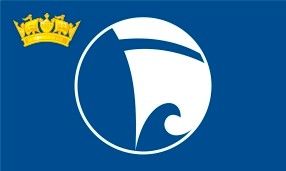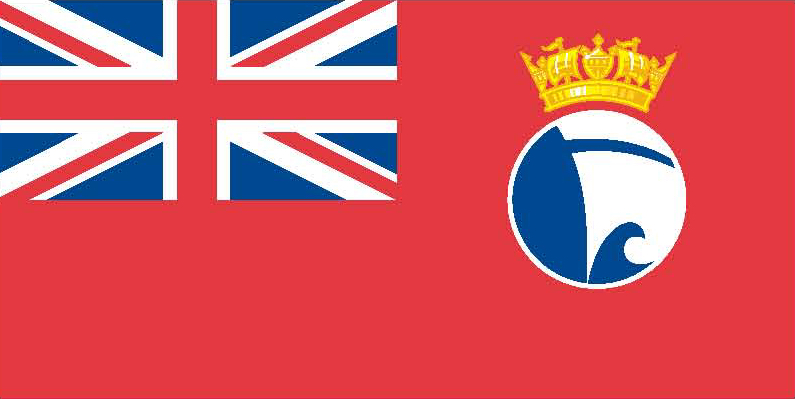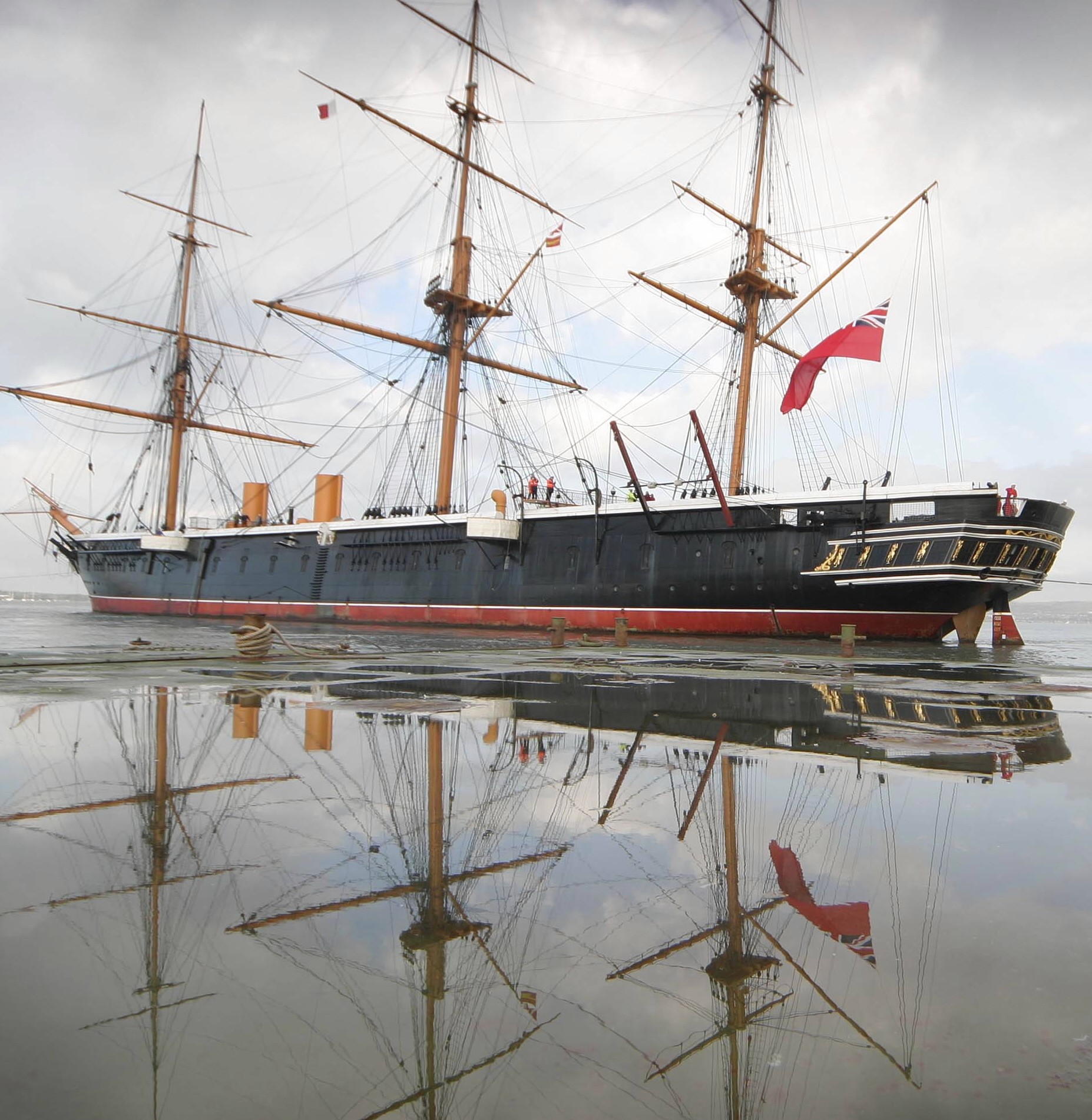


Previous names
- 1916 - 1924 Vernon lll
Details
Construction
Dimensions
History
HMS WARRIOR was built in 1860 for the Royal Navy and she remained in Admiralty ownership until 1923. Her active service lasted 22 years; for the first six years she was in full commission, and for the next eight she was a first line reserve. She entered Portsmouth for the last time under her own steam in 1883 and remained there until she was paid off.
Between May 1901 and July 1902 HMS WARRIOR was used as a hulk for torpedo stores, but in 1902 she was fitted out as a depot ship for the Portsmouth Destroyer Flotilla of small torpedo boats. She flew the pennant of the Flotilla Captain as his flagship.
Between April 1904 and September 1923 HMS WARRIOR served as the floating workshop and powerhouse for HMS VERNON, the Royal Navy’s floating Torpedo Training School. This consisted of three ships in line connected by aerial walkways. HMS WARRIOR was located in the middle, and supplied steam and electricity to the other hulks. Her engines and boilers were removed and modern watertube boilers were installed to provide the power needed in her new role. Her boiler room was used as a machine shop.
HMS WARRIOR’s First World War story illustrates how the Navy made full use of all its available resources. The wooden steam battleships MARLBOROUGH of 120 guns and DONEGAL of 100 guns were the other two vessels making up HMS VERNON. DONEGAL served as an instructional ship with lecture rooms, whilst MARLBOROUGH served as the living and accommodation ship. HMS VERNON became a conspicuous feature of the Portsmouth harbour during this period. During the War the name HMS WARRIOR was taken for a new armoured cruiser, which was sunk at the Battle of Jutland in 1916. DONEGAL was renamed VERNON I, MARLBOROUGH was renamed VERNON II, and WARRIOR was renamed VERNON III. WARRIOR resumed her original name in October 1923.
The need to train large numbers of sailors in torpedo warfare in the early years of the war meant that HMS VERNON operated at bursting point; thousands of cadets passed through. Additional resources were required to keep up with the demands placed upon her. In 1916 the Second Class Cruiser HMS FORTE was moored alongside VERNON III for use as offices and additional living accommodation; and between 1916 and 1923 a number of submarines and a barrage vessel were attached to the School to assist with the power supply.
Many illustrious sailors served on WARRIOR over the years, including Admiral of the Fleet Lord Jackie Fisher, who served on WARRIOR as a gunnery lieutenant between 1863 and 1864. Sir Henry Jackson, who went on to replace Fisher as Admiral of the Fleet in 1915, attended HMS VERNON in 1881 (before WARRIOR joined her). After qualifying as a torpedo officer, he joined the directing staff there. Jackson was a pioneer of ship-to-ship wireless technology; he was the first to demonstrate continuous communication with another vessel up to three miles away.
Daily life on board HMS VERNON has been recorded by a number of those who served on her. One such was John Hanley, who was a British trainee electrical artificer on HMS VERNON at Portsmouth between 1918 and 1921. In a recorded interview for the Imperial War Museum he described the daily routine of the VERNON trainees. They were turned out of their hammocks at 6.30am, got dressed and went for breakfast at 8am, and at 8.30am they were mustered on the quarterdeck of HMS WARRIOR for prayers, after which they did exercises on deck before going off to their respective workshops or classes.
After periods as a depot ship and part of HMS VERNON she was paid off in 1924. She was then converted for use as a floating oil jetty and in 1929 was towed to Pembroke Dock where she was to remain for the next 50 years. In 1967 the campaign to restore WARRIOR started and prominent in this was Sir John Smith who formed the Manifold Trust. A committee chaired by the Duke of Edinburgh met in 1968 to discuss her future and from this emerged the Maritime Trust. When Pembroke Dock closed in 1978 the Manifold Trust agreed to underwrite the cost of restoration and the ship was handed over to the Maritime Trust in 1979.
In 1983 ownership was transferred to the Ship’s Preservation Trust which became the Warrior Preservation Trust in 1983. Although the hull was very sound the rest of the ship was in a poor state. The task which was part restoration and part re-building needed vast resources not only of money (£8M) but also of skill, patience and endurance. The 8 year restoration programme at Hartlepool transformed her into one of the world’s most important historic warships and in 1987 she returned to Portsmouth where she is now moored in the Historic Dockyard.
A planned preservation programme is in place for the ship and over the years she has been dry-docked twice, and the upper deck, (£725K provided by the Heritage Lottery Fund), all three fighting tops and half moons and the stern gallery have been replaced.
Source; David Newberry, Advisory Committee, December 2008
Key dates
-
1861
Commissioned by the Royal Navy as the largest warship in the world
-
1871
Superseded by faster ships, downgraded to Coastguard and reserve services
-
1883
Placed on the reserve
-
1904
Converted to a floating school for the Navy and renamed VERNON III
-
1924
Put up for sale as scrap
-
1929
Converted into a floating oil pontoon and renamed OIL FUEL HULK C77
-
1983
Ownership transferred to the Warrior Preservation Trust and underwent restoration at Hartlepool
-
1987
Returned to Portsmouth Historic Dockyard for display
Grants
-
Dec 2016
An award of £18,00 was award by the Wolfson Foundation toward the cost of their archive
-
2015
The Heritage Lottery Fund has awarded £2.6 million to the HMS Warrior Preservation Trust to undertake vital repair works
-
2013-2014
The Heritage Lottery Fund awarded £2,658,000 for repairs to the bulwarks, interpretation and making the archives more accessible
-
2000-2001
The Heritage Lottery Fund awarded £725,000 for the replacement of the upper deck
-
1994
The National Heritage Memorial Fund awarded £75,000 for dry docking
-
1987
The National Heritage Memorial Fund awarded £100,000 for restoration works
-
1982
The National Heritage Memorial Fund awarded £50,000 for upper deck repairs
Sources
Wells J G, Mariner's Mirror: HMS Warrior 1860 - Progress Report No 2, pp165-6, Volume 71, Edition 71, 1985
Dulake, Robin, HMS Warrior Britain's First Ironclad, Warrior Preservation Trust, 1987
Brouwer, Norman J, International Register of Historic Ships, Anthony Nelson, pp180, Edition 2, 1993
Sullivan, Dick, Old Ships, Boats and Maritime Museums, Coracle Books, 1978
Andrew Lambert, Restoring the World's First Ironclad (1987)
John Wells, The Immortal Warrior - Britain's First and Last Battleship (1987) pub: Kenneth Mason Publication Ltd
John Winton, Warrior, the First and Last (1987)
Walter Brownlee, Warrior: The First Modern Battleship (1985) pub: Cambridge University Press
Classic Boat: Tell Tales, pp19, June 2015
Wells, J G, Mariner's Mirror: HMS Warrior 1860: a Progress Report, pp74-5, Volume 70, Edition 70, 1984
Wells, J G, Mariner's Mirror: HMS Warrior - Progress Report No 3, pp462-3, Volume 58, Edition 58
Wells, J G, Mariner's Mirror: HMS Warrior's Figureheads, Volume 69, Edition 69, 1983
Ships Monthly: Warrior leaves her Haven, pp32-3, November 1979
Ships Monthly: Return of Warrior, pp25, August 1987
Hargreaves, Roger, The News (Portsmouth): Chance to buy stake in future of Warrior, 17 May 2000
Wells, John, Warship World: Warrior: the final preparations, Spring 1987
Own this vessel?
If you are the owner of this vessel and would like to provide more details or updated information, please contact info@nationalhistoricships.org.uk












